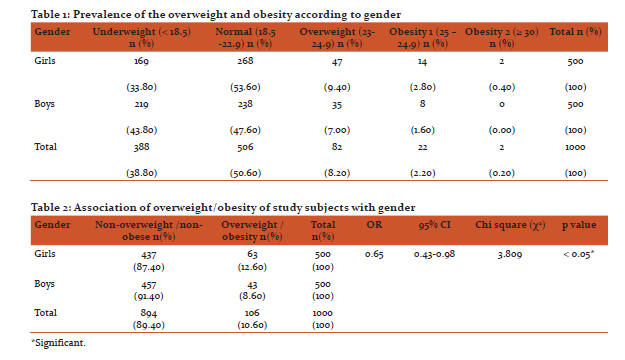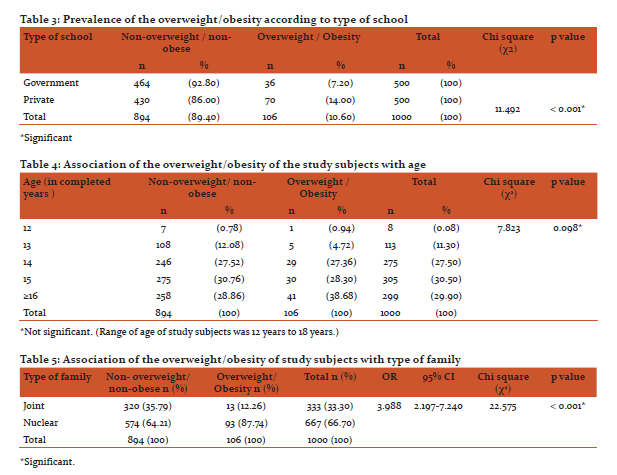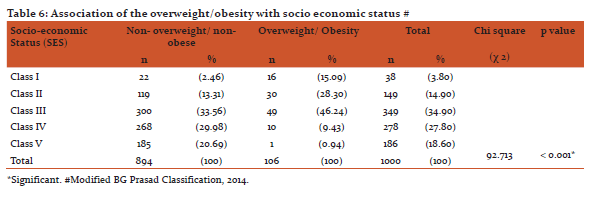IJCRR - 10(8), April, 2018
Pages: 33-37
Date of Publication: 28-Apr-2018
Print Article
Download XML Download PDF
An Epidemiological Study of Overweight and Obesity in High School Children of Udaipur City, (Rajasthan)
Author: Shiv Lal Solanki, Bhagraj Coudhary, Bharat Meharda, Abhilasha Mali
Category: Healthcare
Abstract:Background: Obesity is a condition of accumulation of abnormal or excessive fat in adipose tissue, to the extent that health may be impaired. Obesity is commonly caused by excessive food energy intake, lack of physical activity and genetic susceptibility. Few cases of obesity may be caused by endocrine disorders, medications and psychiatric illnesses.
Objectives: To study the socio demographic profile and the prevalence of overweight/obesity in school children of Udaipur city.
Materials and Methods: This cross-sectional study was conducted from July 2014 to June 2015, on 1000 students of class 8th, 9th, 10th of government and private schools of Udaipur city (Rajasthan). Pre-tested questionnaire was used to collect socioeconomic and demographic information with prior consent.
Results: Girls (12.6%) were more, overweight/obese, than boys (8.6%). Overall prevalence of overweight/obesity was 10.60%, and the prevalence was nearly double in private schools (14.0%) than government schools (7.2%). Prevalence of overweight/ obesity was (38.68%) in the study subjects aged ≥16years, followed by (28.30%) in 15 years, (27.36%) in 14 years and less values in age 13 and 12 years. (87.74%) of the subjects with overweight/obesity belonged to nuclear families, (89.63%) were from SES I, II, and III while (10.37%) to class IV and V.
Conclusion: Obesity is a key risk factor for emergence of chronic and non-communicable diseases, several years later in life; hence the school curriculum should include the regular educative sessions on nutritive values of different food stuff, hazards of obesity, protective food habits and healthy life style.
Keywords: Prevalence, Nuclear family, Socio economic status, Gender
DOI: 10.7324/IJCRR.2018.10807
Full Text:
INTRODUCTION:
Adolescent population is frequently exposed to rapidly changing values, modernized means of communication, and hostile culture with adverse life style and unhealthy nutrition practices, which affects their health. The consumption of fast food is associated with increased risk of excess weight, body fat, poor dietary quality and diabetes.
At present children are changing the nature of their leisure activities, from actively participating in sports and physical activities to electronically played games,spend more time with computers, mobile phones resulting to sedentary life style practices. Diet and lifestyle are ostensibly major contributors to weight problems and varies with different socio-economic conditions. Obesity can be seen as the first wave of a defined cluster of non-communicable diseases called “New World Syndrome” creating an enormous socio-economic and public health burden in poorer countries1. Obesity is a serious health problem and its prevalence has increased dramatically over the past 20 years. Today it is estimated that over 250 million people in low and middle-income countries suffer from obesity and in India the obesity epidemic is a growing concern for public health planning. The International obesity task force (IOTF) has calculated the 10% global prevalence of obesity in children of 5-17 years. India is one of the capitals of diabetes and cardiovascular diseases. The WHO has already declared obesity, a global epidemic that constitutes one of the biggest current health problems.
Objectives
To study the socio demographic profile and the prevalence of overweight/obesity in school children of Udaipur city.
Materials and Methods
This cross-sectional study was conducted on 1000 students, of class 8th, 9th, 10th of government and private schools of Udaipur city. Pre-tested questionnaire was used to collect socio-economic and demographic information. Data were analysed using SPSS 20 software, for descriptive and inferential statistical significance tests
Results
Table 1. The prevalence of overweight in 1000 study subjects was (8.20%)‚ followed by obesity I (2.20%), obesity II (0.20%). The values in girls were high for prevalence of overweight (9.40%), obesity I (2.80%), obesity II (0.40%), compared to values among boys, overweight (7.00%), obesity I (1.60), and obesity II (0%) respectively.
Table 2. Out of 1000 study subjects, (10.60%) were overweight/obese. (12.60%) of girls were overweight/obese against (8.60%) of boys. Statistically significant association was found between overweight/obesity and gender of study subjects with p < 0.05 (χ2 3.809). The odds of being overweight and obesity was 0.653 times more in girls as compared to boys.
Table 3. In the present study, the prevalence of overweight/obesity in private schools was observed higher (14.00%), against the government (7.20%). Statistically significance was found in prevalence of overweight and obesity and type of school with p < 0.001 (χ2-11.492).
Table 4. Majority (38.68%)of overweight/obese study subjects, were aged ≥16 years, followed by (28.30%), (27.36%), (4.72%), (0.94%) of age 15 years, 14 years, 13 years and 12 years respectively. Statistically significant association was not found between overweight/obesity and age of study subjects with p = 0.098 (χ2 7.823).
Table 5. Majority (87.74%) of the study subjects belonged to nuclear family and rest from joint. Statistically significant association was found between overweight/obesity and type of family of study subjects with p < 0.001 (χ2- 22.575).
Table 6. Among overweight/obese study subjects, the majority (46.24%) belonged to class III SES, followed by (28.30%) class II, (15.09%) class I, (9.43%) class IV and (0.94%) class V, respectively. Statistically significant association was found between overweight/obesity and socio-economic status of study subjects with p < 0.001 (χ2- 92.713).
Overall prevalence of overweight/obesity
In the present study, the overall prevalence of overweight/obesity was observed (10.60%) among 1000, school going children of Udaipur city. The prevalence of overweight was (8.20%)against obesity of (2.40%). This is comparable to studies done in different parts of India, on school going children came out with prevalence of overweight/obesity ranging from (5.60%to 27.00 %)
A study at Ahmedabad2, observed, the overall prevalence of overweight/obesity (14.00%), overweight (11.8%)and obesity (2.2%)while study in Latur3 found the overall prevalence of overweight/obesity (9.98%), overweight (8.54%) and obesity (1.44%). Study at Karnataka4 found the overall prevalence of overweight/obesity (9.63%), overweight (4.50%) and obesity (5.13%). High prevalence was found at study Tamilnadu5, overweight/obesity (27.00%), overweight (20.00%) and obesity (7.00%). Low prevalence was observed at study Dakshina Kannada, and Udupi districts6, the overweight/obesity (5.60%), overweight (3.00%) and obesity (2.60%). Variations reported in the prevalence of overweight/obesity in school going children may be due to that these studies were conducted at different times in different geographical areas with different parameters.
Association of prevalence of overweight/obesity with gender
In the present study, the prevalence of overweight/obesity was found more in girls (12.60%) as compared to boys (8.60%) with the odds of 0.65 and the difference was found statistically significant.
Similar findings were reported by study at Shimla9in which overweight/obesity was observed more in girls (2.60%) against boys (1.2%), and study in South India7 observed more overweight/obesity in girls (11.66%) to boys (10.36%), though the difference was not significant. Study at Punjab10, also observed more number of girls, overweight/obese compared to boys. A higher prevalence of overweight has also been reported in girls (20%) than boys (16.4%) in study conducted at Thiruvananthapuram2, whereas the study6 observed nearly equal prevalence of obesity in boys (6%) and girls (5.3%). The overweight/obesity, observed more in girls could be due to the fact that during puberty, females have tendency to accumulate more fat. It is a recognized fact that weight gain during puberty is physiological, and is accompanied by increase in BMI and subcutaneous adiposity11.
Prevalence of overweight/obesity according to type of school
In the present study, prevalence of overweight/obesity was observed (7.20%) in government schools against (14.00%) in private schools with the odds of 2.098 times among private school children and the difference was found to be statistically significant.
Similar findings were observed in a study carried out in South India7 in which the prevalence of overweight/obesity was (6.26%) in government schools while (15.76%) in private schools and the association between overweight/obesity and type of school was observed statistically significant. In the study2, the prevalence of overweight/obesity was observed in govt. school (17%) while in private (22.2%), further in the study conducted among school children at Anantnag8 , the prevalence of overweight/obesity was observed (4%) in govt. schools while (20%) in private schools. Low prevalence of overweight/obesity was observed at Shimla9, (0.40%) in the govt. schools against (3.40%) in private schools, whereas nearly equal results were observed by study6, the prevalence in govt. schools (6%) and in private schools (5.25%).
Since children studying in private schools may have a better socio-economic background belonging to well-fed families, have a major role in the observation of high prevalence of overweight/obesity.
Prevalence of overweight/obesity and its association with age:
It is observed here that there was rise in prevalence of overweight/obesity with advancement of age, the prevalence was observed (0.94%)at age 12 years, (27.36%) at 14 years age and (38.68%) at age ≥16 years. Our findings are supported by study6, observed the prevalence of overweight/obesity at age12 years (3%), increases to (9.0%) at age 15 years. Similar findings were also observed by study at Thiruvananthapuram2 and Chennai12. The study at Puducherry13, observed high prevalence of overweight/obesity in higher age group and a positive correlation was found between age and obesity. Perhaps it is because of increased adipose tissue and overall body weight in children with increase of age during puberty14. But the study done at Ludhiana15 showed that the prevalence of obesity was decreased significantly with increase in age, (18.5%) at 9 years to (7.6%) at age 14years, and raising to (12.1%)at age 15 years.
Association of prevalence of overweight/obesity with type of family
In the present study the prevalence of overweight/obesity was observed in majority belonged to nuclear families (87.74%) against (12.26%) joint families with the odds of 3.988 and the association was found statistically significant. Similar findings, (20.7%) nuclear and (13.%) joint were observed by study2 while in study done at Rohtak16 observed the nuclear (53.%) and joint (46.9%) and study at Dakshina Kannada and,Udupi districts by6 found the prevalence of overweight/obesity (7%) in nuclear and (4%) in joint family.
Association of prevalence of overweight and obesity with socio economic status
In the present study, high prevalence of overweight/obesity was found among class I, II, III SES (89.63%) and low (10.37%) in class IV and V SES. There was an increase in prevalence of overweight/obesity with increase in socio-economic conditions and this association was found, statistically significant. Our findings are similar to studies done at Shimla9, showing higher prevalence of overweight/obesity in the high socio-economic groups SES I (1.9%), II (1%), III (0.3%), and low in IV (0.1%), while in study at Mysore17 observed high prevalence in SES I (21.7%), II (19.4%), III (14.5%), and low in IV SES (1.4%). In a study2, more obesity (38.6%) was observed with monthly income of Rs >6000, compared to low obesity in Rs 6000 (15.7%). The study16 reported (11.7%) of overweight/obesity in higher income group against (6.1%) in lower income group.
CONCLUSION
On the background of findings of prevalence pattern of overweight/obesity in present study, orientation sessions to be campaigned in the schools for primary prevention of obesity, for educating adolescents about the hazards of obesity, danger of emergence of hypertension, diabetes, coronary heart disease and chronic illnesses in future life. Obese school children to be counselled to restrain for taking high energy foods and to adopt the healthy life style practices with sports and physical activities. We have to strengthen the social mobilization activities to educate the public, for building healthy future generation, by creating awareness to combat childhood obesity.
ACKNOWLEDGEMENTS Authors acknowledge the immense help received from the scholars whose articles are cited and included in references of this manuscript. The authors are also grateful to authors/editors/publishers/ of all those articles, journals, and books from where the literature for this article has been reviewed and discussed.
Funding: No funding sources.
Conflict of interest: None declared
Ethical approval: Approved by the Institutional Ethics Committee.



References:
- World Health Organization. The Asia-Pacific perspective: Redefining obesity and its treatment. 2000.
- Ramesh K Goyal, Vitthaldas N Shah, Banshi D Saboo, Sanjiv R Phatak, Navneet N Shah, Mukesh C Gohel, Prashad B Raval, Snehal S Patel. Prevalence of overweight and obesity in Indian adolescent school going children: its relationship with socioeconomic status and associated lifestylefactors. Maharashtra Chapter of Association of Physician of India, JAPI, March 2010;58: 151-58.
- Soniya V, Ashtekar, Sarita B, Mantri, Atul V, Wadagale. Prevalence and epidemiology of overweight and obesity among upper primary school children in Latur city. Med Pulse – International Medical Journal. 1 January 2014;1(1): 15-19.
- Asha B., Mahendra B.J., Harish B.R. A study of correlates of overweight/ obesity among high school children of Mandya city, Karnataka. International Journal of Current Research. January 2015; 7(1): 11594-11598.
- S. Brinda Devi, K. Anusuya Devi. Socioeconomic status, physical activity, and sedentary lifestyle of obese school children 6-15 years of age. International Journal of Food and Nutritional Sciences. Apr-Jun 2015; 4(3): 77-82.
- Keerthan Kumar M., Prashanth K., Kavya Elizabeth Baby, Kavya Rashmi Rao, Kumarkrishna B., Krishnamurthy Hegde, Mrinal Kumar, Manish Shetty, Navya N., Kavya C.P., Sandeep Kumar G. and Rahul R. Prevalence of obesity among high school children in Dakshina Kannada and Udupi districts, NITTE University Journal of Health Science. December, 2011;1(4): 16-20.
- HM Thippeswamy, N Kumar, S Acharya, K C Pentapati. Relationship between body mass index and dental caries among adolescent children in south India. West Indian Medical Journal. 2011;60(5): 581-586.
- Dr. Naheed Vaida. Prevalence of obesity among children studying in government and private schools in district Anantnag age group (6-12 years), IOSR Journal of Pharmacy, February 2013; 3(1):04-11.
- Anjali Mahajan, Prakash Vhand Nagi. Prevalence of overweight and obesity in urban school going adolescents in shimla city. International Journal of Nutrition, Pharmacology, Neurological Diseases. December 2014; 4(1):23-28.
- Jasvinder Kaur Sangha, Amandeep Kaur Pandher and A. Kochhar. Anthropometric profile and adiposity in the obese Punjabi children & this parents. J. Hum. Ecol. 2006; 19(3): 159-162.
- Christine M., Burt Solorzano, Christopher R, McCartney. Obesity and the pubertal transition in girls and boys. Reproduction. Sept 2010;140(3): 399-410.
- Ramachandran A, Snehalatha C, Vinitha R, Thayyil M, Kumar CKS, Sheeba L, et al., Prevalence of overweight in urban Indian adolescent school children. Diabetes Res Clin Pract. 2002; 57(3):185-190.
- Mohanty B, the prevalence of overweight / obesity in school going children of Pondicherry. Study sponsored by- Department of Science and Technology and Environment. Government of Pondicherry. 2007-08.
- Avula Laxmaiah, Balakrishna N, Kamasamudram V Mohanan N. Factors Affecting Prevalence of Overweight Among 12 to 17 years-old Urban Adolescents in Hyderabad, India. Obesity. 2007; 15:1384-1390.
- Jugesh Chhatwal, Manorama Verma, Sandeep Kaur Riar. Obesity among pre-adolescent and adolescents of a developing country (India). Asia Pac J Clin Nutr. 2004; 13(3):231-235.
- Ravi Rohilla, Meena Rajput, Jyoti Rohilla, Manisha Malik, Dinesh Garg, Madhur Verma. Prevalence and correlates of overweight/obesity among adolescents in an urban city of north India. Journal of Family Medicine and Primary Care. October 2014; 3(4): 405-408. H.S. Kavita, N.C. Ashok. Prevalence of Obesity among Primary school children and its Association with Parental obesity and Socio-economic status. Medica Innovatica June 2013; 2(1):26-3
|






 This work is licensed under a Creative Commons Attribution-NonCommercial 4.0 International License
This work is licensed under a Creative Commons Attribution-NonCommercial 4.0 International License